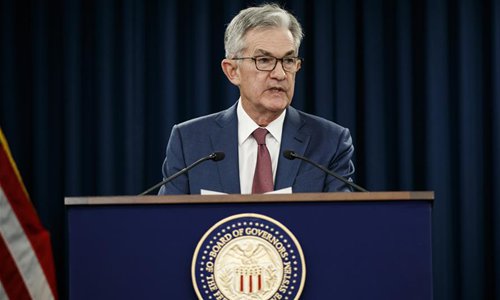HOME >> SOURCE
Hotter manageable inflation is the best surprise to hope for in 2020
By Global Times Source:Global Times - Reuters Published: 2020/1/6 18:48:40

U.S. Federal Reserve Chairman Jerome Powell speaks during a press conference in Washington D.C., the United States, on Oct. 30, 2019. U.S. Federal Reserve on Wednesday lowered interest rates by 25 basis points amid a further slowdown in U.S. economic growth, the central bank's third rate cut this year. (Photo by Ting Shen/Xinhua)
The death in December of Paul Volcker, former chairman of the US Federal Reserve (Fed) and famed inflation-fighter, is a reminder that galloping price increases used to be a problem. In recent years, though, inflation has largely gone missing. Its return in 2020 would be an unexpected bright spot.Not, of course, the kind of inflation Volcker countered with tough monetary policy in the early 1980s, when annual price increases topped 10 percent in the US. Or the debilitating 50 percent annual rate in Argentina as of October. But there's a lot to be said for modest price gains.
The failure of US price pressures to gain much momentum, starting with wages, is a head-scratcher given the tight labor market evinced by an unemployment rate of a mere 3.5 percent in November. The country's consumer price index rose 2.1 percent in the year to November. That metric clears the central bank's 2 percent symmetrical target but doesn't make up for long periods of much weaker inflation since the financial crisis.
In turn, this contributes to low interest rates, which in the past decade or so have changed the financial world. Central bankers like New York Fed President John Williams like to talk about "r-star," the real interest rate that's natural for a healthy economy. Economists think the theoretical r-star has become lower than it used to be thanks to aging populations, lower productivity growth and other factors. Add weak inflation, and the nominal interest rate matching r-star is also low.
That's why the Fed's target rate is far lower than the historical average, in the 1.5 percent to 1.75 percent range. In Europe and Japan, key policy rates are less than zero. That's a huge challenge for pension funds, some targeting long-term 7 percent-plus annual returns on their often-underfunded portfolios, insurance companies seeking safe investments, and risk-averse savers. It's also problematic for banks trying to lend profitably.
It's hard to find hints of a resurgence in inflation. True, the impact of US President Donald Trump's tariffs could push prices up. But globally, the International Monetary Fund, for example, is more worried about the reverse - even if BlackRock, the giant asset manager, thinks inflation risks are underappreciated. Maybe the best hope for a resurgence of manageable inflation is that the consensus is largely dismissing the possibility. Otherwise, there will be more painful adjustments to a new, low-interest-rate future.
The author is Richard Beales, Reuters Breakingviews columnist. The article was first published on Reuters Breakingviews. bizopinion@globaltimes.com.cn
Posted in: INSIDER'S EYE